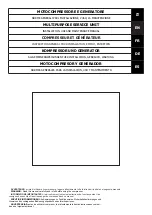
20
When the oil temperature reaches 75
C, the thermostatic valve (U9 closed
completely and from then on all the oil in circulation goes through the radiator and is
thereby cooled (M).
From the radiator (M) the oil is injected into the compressor (O).
The filter (V) has an internal "by-pass" valve which permits oil circulation even if
it gets blocked. In which case the oil will circulate regularly without being filtered. It is
therefore necessary to replace the filter at regular intervals, as indicated in the
maintenance programme.
The cooled and filtered oil thereby reaches the compressor (O) and by means
of the various internal channels it is distributed to the various parts (rotors, bearings etc)
which are thereby cooled and lubricated. From the compressor (o), the oil mixed with
compressed air is sent to the tank (Z), inside which the separator (Y) undertakes to
separate it from the air.
We have mentioned that the separator filter (Y) provides to separate the air
from the oil; however a very small quantity is still able to penetrate the inside of the filter,
and deposits itself on the low and concave part of the same. It is sucked through the
piping on which the calibrated nozzle and the single-direction valve are positioned. The
latter impedes the return of oil into the oil separator filter when the machine is stopped.
--
5-9-2) PNEUMATIC SYSTEM
(Fig. 3)
--
The system includes: the suction filter (A), the suction regulator (B), compressor
(O), tank (Z) and the oil separator element (Y), the minimum pressure and non-return
valve (L), the cock (R) and the maximum pressure valve (G), and the discharge solenoid
valve (P).
The suctioned air, after having passed through the double stage filter (A)
reaches the suction regulator, followed by the compressor which conveys it, together with
the injected oil, into the oil separator tank. Where the air is separated from the oil. This
separation process firstly comes about by means of centrifugal spinning and in the second
stage with the use of the oil separator filter (Y).
The air which is cleansed of the oil, is conveyed by the minimum pressure valve
(l), and only opens when the pressure in the tank reaches the pre-set value. This minimum
pressure formed in the tank guarantees oil circulation even when the air discharge taps
(R) are in fully open position.
It is however a good idea not to use tools and equipment, which excessively
consume compressed air, and which may cause the tank pressure to fall to below 5-5.1
bar.
In fact prolonged working conditions at below 5 bar, may cause compressor
overheating, due to insufficient lubrication, and inadequate air and oil separation, resulting
in excessive lubricant consumption.
The solenoid valve (P), on stopping the machine, opens automatically, gently
discharging all the compressed air still inside the system into the atmosphere.
The minimum pressure valve (L) also acts as a single-direction valve,
impeding return into the compressed air unit of air coming from channels or tools
connected to the machine.
Содержание MDVN 71 AP
Страница 2: ...2...
















































